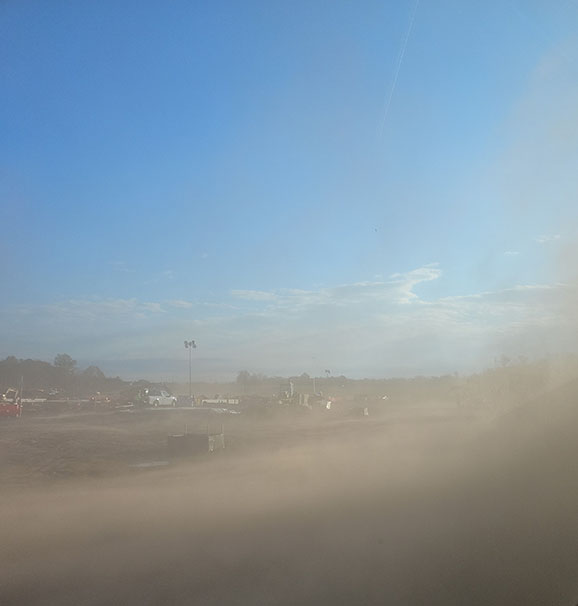The Importance of Dust Control on Construction Sites
HazTek Safety Professional CJ Rumpf recently shared this photo showing the need for dust control on construction sites. Pictured here is a construction site next to an airport. Every time a plane takes off, dust flies up and creates issues for the workers on site.
Dust control measures apply to any construction site where major soil disturbances or heavy equipment construction activities — such as clearing, excavation, demolition, or excessive vehicle traffic — occur. Earthmoving activities, particularly transport of cut and fill materials, are the major source of dust from construction sites (Muleski et al., 2005), but traffic and general disturbances can also be significant contributors (WA Dept. of Ecology, 1992).
Dust control measures are especially important in arid or semiarid regions, where soil can become extremely dry and vulnerable to transport by high winds. The most effective dust control measures for a site depend on its topography and land cover, soil characteristics, and expected rainfall.
Below are examples of how workers can control dust on construction sites:
- Sprinkling/irrigation – Sprinkling the ground surface with water until it is moist is an effective dust control method for most sites, particularly on haul roads and other traffic routes where other dust control methods may not be possible
- Vegetative cover – In areas that construction staff do not designate for vehicle traffic, vegetative cover reduces wind velocity at the ground surface, thus reducing the potential for dust to become airborne
- Mulch – Mulching can be a quick and effective dust control method for a recently disturbed area
- Wind breaks – Wind breaks are barriers (either natural or constructed) that reduce the velocity of wind through a site, thereby reducing the number of particles the wind suspends. Wind breaks can be trees or shrubs that construction staff leave in place during site clearing or constructed barriers such as wind fences, snow fences, tarp curtains, hay bales, crate walls or sediment walls
- Tillage – Deep tillage in large open areas brings soil clods to the surface where they rest on top of dust, preventing it from becoming airborne
- Stone – Stone can be an effective dust deterrent for construction roads and entrances or serve as a kind of mulch if the area that cannot establish vegetation
- Chemical soil stabilization (palliatives) – There are several different categories of chemical soil treatments: water absorbing, organic non-petroleum, organic petroleum, synthetic polymer emulsion, concentrated liquid stabilizer and clay additive (Jones, 2017). Factors to consider when selecting a chemical application for dust suppression include biodegradability, soil suitability, and impacts to wildlife and environmentally sensitive areas
For more information, visit: https://www.epa.gov/.../docu.../2021-11/bmp-dust-control.pdf
Credit: Environmental Protection Agency
Learn more about HazTek Safety & OSHA Training.
